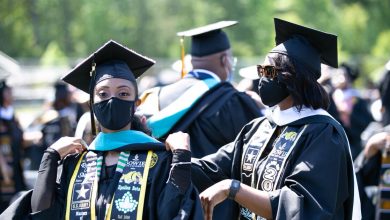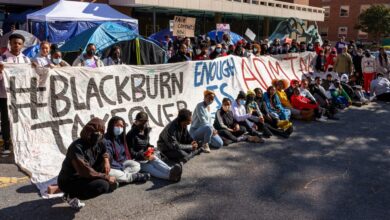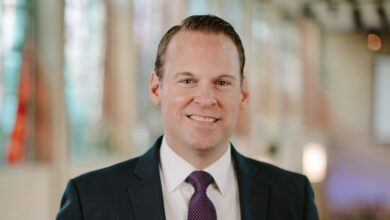Raising Graduation Rates Takes a Culture Shift — and a Lot More

At first, Menendez thought he could power through. When he got a few low C’s, he didn’t sweat it, since he often stumbled in the first few weeks of class. He knew he would get check-in emails from Adrienne Pollard, in the University of South Florida’s Office of Academic Advocacy. Her dashboard signaled which students were struggling academically, prompting her to send friendly messages along the lines of, Hey, I see that you’re having some trouble in this class; here are a few resources you might want to check out.
Raising graduation rates takes a culture shift — and a lot more.
Menendez ignored the messages, as he had done before. “I grew up with: your problem, you fix it, do not ask for help,” he says of his traditional upbringing in Colombia and later the United States. Universities, to him, were like government offices: uncaring bureaucracies.
But as his family pressures increased, Menendez found himself shaking uncontrollably. Sometimes he would step out of class to throw up. Finally, in March, he sent Pollard two emails and left a voice mail for good measure. She got back to him within hours, setting up a meeting the next morning. Within days he had a case manager and access to a host of services, including mental-health counseling. Equally important, Pollard explained how to petition to withdraw from several of his courses without any academic or financial penalties, and finish in the fall.
For more than a decade USF has been working to catch students like Menendez before their problems snowball. That takes more than adding a layer of support to the existing university structure. Rather, USF — along with a growing number of large, diverse public institutions — is trying to engineer a better student experience by improving communication across offices, reorienting jobs, and creating new entities, like the Office of Academic Advocacy. This kind of change isn’t easy, nor does it come without challenges, but it has shown results: USF has boosted its four-year graduation rates by 33 percentage points since 2009. Even so, getting the right help to every struggling student is hard.
Although the services that helped Menendez had been at his disposal all along, he says he was either unaware of them or didn’t think they applied to him. The byzantine university bureaucracy — both real and imagined — had blocked his path. Without a guide, he believes, he probably would have wrecked his GPA and damaged his chances for graduate school.
“Ms. Pollard served as the first domino in a Rube Goldberg machine,” he says. She was “like a cool aunt who comes in and says, everything is going to be fine. I’ve got you. She was an authority figure I could look up to and not feel afraid.”
Why do universities struggle to do something that’s clearly in both the public interest and their own?
Unsurprisingly, many ran into problems. They were locked out of course registration for unpaid fines. They racked up more credit hours — and thus more bills — than they needed to graduate because they switched majors late in their academic career, or enrolled in the wrong prerequisites. They struggled needlessly in their classes because they weren’t aware of academic-support services or thought they were intended for others. They failed to connect with classmates on sprawling campuses where they might not see the same faces in a series of unconnected courses.
Decades into what has become known as the student-success movement, many of those barriers remain. One recent study of student transcripts found that a third of those who had completed the academic requirements of college but never earned their degree were missing a major-specific course, and one in 10 were derailed by small problems, such as a financial hold because of a parking fine. These stumbling blocks disproportionately affect students from low-income backgrounds, first-generation students, and students of color.
Those barriers also carry a substantial collective cost. While the vast majority of students enter college expecting to graduate in four years, fewer than half do and less than 65 percent graduate in six. Those figures are even lower for Black and Hispanic students. Given the growing cost of a degree, and the fact that it is shouldered by a student body that is increasingly lower-income, racially and ethnically diverse, and first generation, these rates remain indefensibly low, reformers argue.
Public universities are under increased pressure to fix those problems. The Florida Legislature is one of more than two dozen state legislative bodies to use performance-based funding, measuring its institutions on how quickly they get students through college, among other things. Grant makers, too, are calling on universities to close retention, graduation, and equity gaps. And as many states expect their college-aged populations to drop, holding on to students once they’re enrolled is a matter of institutional survival.
Timothy M. Renick, who runs Georgia State University’s National Institute for Student Success, where he advises about 40 colleges, says speaking of reforms in terms of money saved clarifies the existential nature of what’s at stake for students and for colleges. He recently gave a presentation to a college in the Midwest that is enrolling a more diverse student body even as it faces a graduation gap of 20 percent between white and Black students. “That’s a moral issue they’re facing,” he says. “But also a revenue issue.”
Why do universities struggle to do something that’s clearly in both the public interest and their own? Why, decades into the movement, do so many universities have ad-hoc advising systems, overly complex academic programs, and uncoordinated support services?
The answers are as complicated as the problem. Large universities, student-success experts often say, were structured more to support the people working at the institution than the students they serve. Severe staffing shortages and deepening student needs — both driven by the pandemic — have presented significant challenges during the last couple of years. There’s also a cultural reason: a sink-or-swim mentality, born when college served a smaller, more elite population, that continues to linger.
“Higher education was originally designed to train the elite, and in many ways a lot of our policies and procedures and the way we think about challenging students is that same kind of narrative, of the cream will rise to the top,” says Viji Sathy, associate dean of evaluation and assessment in the Office of Undergraduate Education at the University of North Carolina at Chapel Hill, and a longtime advocate for a more inclusive approach to teaching. “That’s really problematic when the landscape of higher education has changed dramatically.”
Higher education was originally designed to train the elite, and in many ways a lot of our policies and procedures and the way we think about challenging students is that same kind of narrative, of the cream will rise to the top.
Viji Sathy, associate dean, UNC-Chapel Hill
Given how difficult it can be to change that dynamic, it’s helpful to look at institutions, like USF, that have made significant strides. The university’s experiences illustrate how engineering a shift in culture, priorities, and systems can take years, requires clear and consistent direction, and is accelerated by external drivers. Success also brings its own tensions and trade-offs.
USF’s strategies reflect the latest thinking on student success, namely that universities must take a holistic approach. They must quickly identify the students most in need of help and offer a range of supports that enable them to overcome obstacles and earn a degree as expeditiously as possible.
Such changes are not only necessary, but increasingly anticipated by today’s students, says Bridget Burns, chief executive officer of the University Innovation Alliance, a collection of large, diverse, public research universities that has made significant inroads testing out such interventions.
“Students have more exposure to user-centered design in the real world than ever before,” she notes. “We have more things offered to us that are designed around our needs in everyday society, and so they are highly sensitive to bad design in a way that no prior generation has been.”
But some professors question whether a focus on time-to-degree ignores other measures of academic quality, such as having a sufficient number of full-time faculty members and advisers available to mentor students. And they worry that instructors may feel pressured to pass struggling students or encourage them to stick with majors that don’t fit if it means racking up excess credit hours. Tracking students raises the specter of Big Brother monitoring their every move through card swipes and clicks in the learning-management system.
Unfortunately, you don’t really change entrenched systems that have been created over hundreds of years by waving a wand and saying, It’s going to happen next year.
Adrianna Kezar, student-success scholar
Colleges may also make substantial investments in predictive- and learning-analytics systems without having the staffing, or the willpower, to confront the problems that they surface, experts say, such as getting students the academic support they need.
“Unfortunately, you don’t really change entrenched systems that have been created over hundreds of years by waving a wand and saying, It’s going to happen next year,” says Adrianna Kezar, a professor of leadership and director of the Pullias Center for Higher Education at the University of Southern California, and a longtime researcher of student-success strategies. “There’s always been this idea that we have to do this urgently, instead of doing it right. “
Those structures include the Office of Academic Advocacy, which tracks struggling students like Menendez and takes a case-management approach to their support. To meet systemic challenges, such as unnecessary holds stopping students’ progress to a degree, the university’s Persistence Committee brings together representatives from more than a dozen offices, including financial aid and the registrar, to recommend solutions. A centrally located Academic Success Center combines previously dispersed support services, such as tutoring, making it easier for students to seek help. And students themselves increasingly play an active role through peer-mentoring programs and enhanced residence-life programming.
A few years later the Florida Legislature introduced performance-based funding, rewarding campuses that met certain metrics on retention and graduation, among other goals. The change in funding served as a sort of rocket fuel for existing efforts, accelerating internal restructuring. In 2018 USF earned the designation of a Preeminent Research University, which brought in additional money. Today USF typically ranks at or near the top of performance-based funding metrics among the state’s public universities. In 2021 its scores earned it an additional $34.5 million.
Today, USF’s freshman-retention rate stands at 90 percent. Its four-year graduation rate is 62.5 percent, and its six-year graduation rate is 74.3 percent. It has retained ethnic and racial diversity, with a student population that is 36 percent Pell eligible. The university has also improved graduation rates among transfer students, who make up about half of undergraduates. Of those with associate degrees attending both full- and part-time, the three-year graduation rate rose to 66 percent from 57 percent over the past six years.
USF did bring in more academically prepared classes, A decade ago, the average incoming freshman had a high-school GPA of 3.86. Last fall it was 4.18. SAT scores rose, as well, to 1293 from 1188.
One administrator uses an analogy common among higher-ed reformers: He wants to see universities become more like health-care systems.
That accounts for some of the retention and graduation gains, says Ralph Wilcox, USF’s longtime provost. But the kinds of internal restructuring efforts the university has undertaken — such as enhanced residence-life and tutoring support, early-alert systems, and changes to long-held policies that disadvantaged some students — have been crucial to helping them make it across the finish line.
“If we were simply to admit higher-ability students without providing them the support inside and outside of the classroom,” he says, “we absolutely would not have realized the gains we have.”
Paul Dosal, who has overseen many of these efforts as vice president for student success, uses an analogy common among higher-ed reformers: He wants to see universities become more like health-care systems.
When a general practitioner refers a patient to a specialist, he says, the specialist has the person’s complete history at hand. Similarly, he hopes that people on campuses with specific expertise — in counseling, advising, financial aid — will eventually have a “360 degree view” of a student’s situation to better understand what they need. “We need to create a network of providers and ensure that our students are referred in a timely way to the best expert for whatever issue that they’re dealing with.”
Student Success is one of the largest units on campus. It includes admissions, enrollment planning and management, residential life, health and wellness, career services and undergraduate studies, and typically employs more than 500 people. Having the ability to better integrate the work of those divisions, Dosal says, is the real challenge. “Creating that network, facilitating the referrals and letting the experts do their job and putting students in front of those experts is where I think we all need to go.”
Renick, of Georgia State University, agrees that for data-driven systems designed to identify struggling students to be effective, they need to be accompanied by people who know how to use them and have the ability to act. And that’s often where colleges fall short.
Administrators will come to him and say: This predictive-analytics system we bought isn’t getting any results. But when he digs in, he finds that the system isn’t the problem, follow-through is. He uses an example: The student who gets a C-minus on his first quiz in an introductory course. A predictive-analytics system may flag that as an early warning sign. But will anyone reach out to the student to make sure they are aware that tutoring is available? Is tutoring tailored to the focus of that particular course? Is it available when students need it, not just on a certain day at a certain time?
Or take another data point available to any college: a student withdrawing from a course. How many colleges have a system in place to reach out to that student within 24 hours to find out why? Probably under 1 percent, Renick says.
While not back to pre-pandemic levels, these gatherings mark a return to normalcy — a welcome relief for many, including administrators who keep a close eye on student persistence. Like many other large, diverse public universities, USF, which enrolls about 37,000 undergraduates across three campuses, saw its drop in its first-year retention rate for the class that arrived in 2020.
As they wrestle with what the future might hold for their students, administrators hope to leave as little as possible to chance.
Before they even set foot on campus, incoming students take a survey designed to measure their sense of engagement with USF, as belonging has been shown to improve student success. Was the university, for example, a student’s third choice? Do they plan to work more than 20 hours a week? About half of the incoming class of roughly 6,000 students may be categorized as higher risk based on their responses to at least three of the questions.
Even students willing to seek help can get lost in a thicket of offices and divisions.
Those students are assigned to a peer adviser leader, or PAL, typically just a year or two older. The adviser is given only students’ contact information. In past years they have been asked to connect at key points during the semester, including at the beginning of the school year, before midterms, and when course registration starts. (This fall, because of staffing shortages, they will reach out once and work with students who respond, the university says.)
Peer leaders and their supervisors say that students are more comfortable sharing their fears and problems with someone close in age. Christina Estevez, a marketing major and PAL, says one student confided that she was struggling in her classes because her parents were divorcing and she felt unmotivated. Estevez encouraged the student to meet with an academic adviser and make an appointment at the counseling center. The student did both and slowly found her footing.
But even students willing to seek help can get lost in a thicket of offices and divisions. The Office of Academic Advocacy, which sits in a low-slung building in the heart of USF’s main campus, is there to catch those who are struggling before their situations spin out of control. There a staff of nine advocates monitor dashboards daily, to track students under their watch.
Some predictive-analytics programs have come under criticism for using demographic data, potentially stereotyping certain student groups as high-risk. They also use proprietary algorithms so that their clients don’t always know what is being evaluated or how. That’s one reason some colleges feel ambivalent about using them.
USF largely uses a homegrown system, which looks only at behaviors. Has a student gone several days without logging in to the learning-management system? Do they have a GPA below 2.3? Have they been on academic probation for several semesters? Are their grades in any given class significantly below their classmates’? The advocates focus on the 10 percent or so of students — out of the thousands under their watch — with the highest risk scores.
Advocates are not mental-health counselors or financial-aid experts or academic advisers, says Leslie Tod, who was appointed the university’s first academic advocate, in 2013, and now leads the office she started.
Rather, they are a first point of contact and a friendly voice who will listen carefully as a student lays out what is often a series of interconnected problems. “We’re working with students who have dug the biggest hole,” she says. “What we do is free up the time of advisers, housing and so on, so they can continue to do their work. So that the same student doesn’t keep coming back.”
One undergraduate Tod spoke to was visually impaired and on anti-anxiety medicine, but had stopped taking it and was not doing well. She was referred to the accessibility-services office as well as to someone who could help with her anxiety. Another struggled with a learning disability and was told — incorrectly — that she would need to foot the bill for an expensive test to confirm it before receiving an accommodation. An advocate helped sort out the snafu. Students often seek out help, too, when their financial aid runs afoul of some rule they were unaware of.
Pollard, who worked with Menendez, says that far from expecting college to cater to them, students often find it difficult to ask for help, believing that they should deal with their problems on their own. Research shows, too, that students who are lower-income or come from underrepresented groups are less likely to seek support or guidance than middle- and upper-income students. That’s a significant risk on a campus where more than a third of students are Pell eligible.
“I am constantly surprised at how many students are experiencing challenges, and it’s affecting their academics, and they don’t ever let their instructors know,” she says. “What we try to do is empower students to advocate for themselves.”
I am constantly surprised at how many students are experiencing challenges, and it’s affecting their academics, and they don’t ever let their instructors know.
Adrienne Pollard, USF academic advocate
While it may be hard to untangle any one student’s problems, it’s even trickier for universities to attack systemic issues. That requires pulling people together across divisions and departments to work on common challenges and giving them the authority to act.
Jennifer Schneider, the university’s one full-time student ombudsman, sits on the Persistence Committee, created in 2016, where the work of digging into these systemwide challenges often takes place.
Schneider manages about 500 students’ cases a year, often some of the most complicated. In her work, she sees patterns invisible to most of the campus. One of the most common questions she asks her colleagues on the committee: Why do we have this rule?
When homeless students told her how fraught it was to have to get written confirmation from a shelter in order to qualify for a tuition-and-fee waiver, she lobbied to switch to a case-management model. That way homeless students can get other forms of support as well, including help finding a place to live. “When we listen to students and give them a voice,” says Schneider, “then we can learn.”
The Persistence Committee also advocated raising to $500 the floor on the size of a debt a student owes the university — say a parking fee or library fines — that would block them from registering the following semester. It did so after concluding that too many students were being stopped for owing as little as $100. That allowed 1,300 more students to register for classes without restriction in one semester alone, says Thomas Miller, chair of the committee and an associate professor of education.
The lesson USF has learned over the years, in short, is this: To help students succeed, sometimes you need to change the university itself.
Some professors worry that an intense focus on retention and graduation metrics without sufficient emphasis on — and support for — strong teaching and academic mentoring could compromise academic quality.
“I think for faculty, student success means, What did our students learn while they’re here? Did they take high-quality classes and put together a coherent program of study that takes them to a better place?” says Boaz, an associate professor in the department of mental-health law and policy. “We shouldn’t be doing things that compromise that side of it in order to meet all these metrics that we’ve set for ourselves related to retention rates and all that kind of stuff.”
Some USF professors feel that their colleges are stretched thin. They need more full-time faculty who can mentor students and more academic advisers to help students pick the best program for them. A faculty-success work group report released in 2019 provided a long list of recommendations to increase support for faculty members. That includes changing a perceived top-down culture and giving deans more decision-making authority, improving faculty salaries, expanding professional-development opportunities, and creating an office of faculty success.
Valerie Harwood, chair of the department of integrative biology, says that her department has five advisers for more than 2,000 majors. She noted that the number of majors in her department has tripled in the past decade even as the number of full-time faculty members has stayed about the same. “We’ve been expected to do a lot with basically temporary employees. And that’s been frustrating.”
Wilcox, USF’s provost, says the university has increased the number of full-time faculty — tenured, tenure-track, and instructional — by more than 200 since 2011 using some of the additional money it has received through performance-based funding. As a result, the student-faculty ratio has dropped to 22:1 from 27:1 over the past decade. But he agrees that some of the fastest-growing areas, like business and engineering, as well as Harwood’s department, are struggling.
“They’re not wrong,” he says of professors’ concerns about the need for more instructors and advisers. “We’re strained to keep pace with the demands of students and the need for more faculty.” He is hopeful that a recent increase in USF’s annual state funding of $55 million may help alleviate faculty and adviser shortages.
As data-driven decision making has taken hold on other parts of campus, so has it touched academic life.
The data-driven approach to student success also troubles some professors and advisers. Studies have documented this ambivalence toward the increased use of analytics, nationally. Some raise questions around the accuracy and validity of algorithms on which the tools were built. Others worry about student privacy.
Diane Price Herndl, chair of the department of women’s and gender studies, says she likes the way analytics can help fix some academic problems. When the administration dug into why some engineering students were falling behind, it turned out the university wasn’t offering enough sections of a required math class, which it fixed by providing the math department more funding. “That is a really, really good strategy,” says Herndl. “A place where this kind of focus on four-year graduation rates really works.”
But she feels conflicted about the student-monitoring and -tracking features that are embedded in such systems. “As a parent, I’m kind of glad to know that if my daughter holes up in her dorm room and doesn’t come out for three or four days at a time, somebody is going to check on her,” she says. “As a faculty member, that feels a little creepy to me. It feels like we’re removing some of the training for adulthood that I want college to be doing.”
USF will need professors’ support as it ramps up efforts to improve teaching and course design. To move their four-year graduation rate to 70 percent from 62 percent, says Dosal, the student-success vice president, that requires more attention to what happens in the classroom. In that, the university is also reflective of a national trend.
Until relatively recently college leaders have been hesitant to look too deeply into professors’ teaching practices and the design of their courses and degree programs. But as data-driven decision making has taken hold on other parts of campus, so has it touched academic life. Deans and department chairs can track which gateway courses have higher-than-average rates of D’s, F’s and withdrawals, or DFWs. They can pinpoint where bottlenecks exist when students try to register for required courses, and whether the degree requirements in certain majors are thwarting timely graduation. All of these are common roadblocks that slow down students’ progress to a degree.
Organizations like the John N. Gardner Institute for Excellence in Undergraduate Education and the Bill & Melinda Gates Foundation have helped focus public attention on the impact that well-structured and well-taught foundational courses can have on a student’s career. And the pandemic has illustrated how inclusive, engaging courses can keep students connected to their college, even in an online environment.
USF has been making inroads into teaching and curriculum design. In one project, focused on curricular complexity, departments have been reviewing degree requirements to ensure that students aren’t being asked to take more credits than necessary and that course sequencing makes sense.
The university has also begun taking steps to increase the use of high-impact practices, such as study abroad and internships, that have been shown to increase student engagement and persistence. And it is working on improving gateway courses with higher-than-average DFW rates.
While professors say they would welcome more resources to strengthen teaching, some worry that academic quality could be compromised by the university’s focus on retention and graduation metrics. Boaz says he’s heard from professors concerned that their colleagues might feel pressure to raise students’ grades. While he has heard no evidence yet to suggest this is happening, he notes the uneasiness is real.
It’s important for us to remember that there is no one-size-fits-all approach to navigating life as a college student.
Tangela Serls, USF assistant professor
Wilcox, who will step down as provost in August and take a faculty position, says that he does not “police” courses with high DFW rates, but rather holds deans and department chairs accountable for determining the root challenges. If a faculty member needs additional training in course design or effective teaching, they may be encouraged to seek that out. Another tool has been to hire more instructors to reduce class sizes, and to expand supplementary instruction.
Other academic concerns relate to the pressure students might feel to move through college expeditiously even when they might be helped by more exploration.
Tangela Serls, an assistant professor of instruction and undergraduate-studies director in the department of women’s and gender studies, says that when she was an adviser in the sciences from 2015 to 2017, she felt that some students would have benefited from extra time to, say, study abroad or do an internship. But her responsibility was to encourage students to finish in a timely manner, without taking on excess credits that might create a financial burden.
“Generally speaking, I don’t really see anything wrong with striving to get students graduated in four to six years,” she says. “But I think it’s important for us to remember that there is no one-size-fits-all approach to navigating life as a college student.”
Dosal, who is leaving USF at the end of June to take a similar role at the University of Central Florida, says that wandering through the curriculum is not an option that low-income students can afford.
In addition to adding on extra tuition costs, a student who spends more than four years in college is losing potential income. “We recognize there are some who oppose the streamlined pathways and still value liberal-arts education and want students to explore as much as they can,” he says. “I know there’s value to that. Unfortunately, we live in a state and in a time in which it can be expensive for students to do that.”
But Herndl argues that this view ignores another aspect of their students’ lives. “It’s our first-generation students, it’s our working-class students, who often have no idea what they want to major in, because they are not exposed to the professional world,” she says. “Those are the students we need to give the most latitude. We need to be offering them ways for exploration instead of trying to push them into a major right away.”
Georgia State found that when students switched majors, it was more often because they couldn’t achieve their goals, not because they had a change of heart. With additional support, more students who expressed an early interest in STEM successfully completed their majors.
He is a believer in structured academic pathways, where freshmen are put into learning communities with a common academic interest or “meta major” like business, health, STEM, and arts and humanities.
“If you allow them to wander aimlessly,” Renick says, “you are going to replicate equity gaps. You are going to disproportionately lead low-income students to drop out with no degree at all.”
Kezar, the USC professor, says colleges would benefit from creating a bigger tent, and bringing everyone into the conversation around student success. She has seen instances where, for example, administrators create guided-pathways programs without sufficient input from faculty members. In others they might hire more advisers, but not consider strengthening the role that professors could play.
“We need more full-time faculty in the first year working with students so that they can talk to faculty about majors and talk to faculty about careers. And we can’t rely on a career center that students rarely ever go to to help them make these choices. We need to be much more actively involved, and faculty are a huge part of that.”
The pandemic threw a curve ball at higher education, making student-success efforts all the more complicated for many universities. Some, like USF and Georgia State, say their early-alert analytics systems continued to help catch students who might otherwise have simply disappeared from their rolls. At the same time, students’ academic, financial, and mental-health needs have grown exponentially in the past two years.
Burns, head of the University Innovation Alliance, also noted the effects of the staffing crisis throughout higher education. Still, she says, “it’s all long-game work.” And to that end, the pandemic has forced colleges to be quicker, more nimble, and more resilient.
Student-success leaders say that while much work remains to be done, universities increasingly understand that improving the undergraduate experience is, at heart, a design challenge. As USF’s experience illustrates, that’s no easy lift. But it’s far from impossible.
Source link






